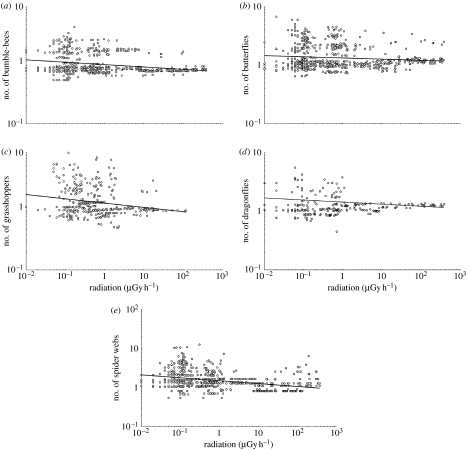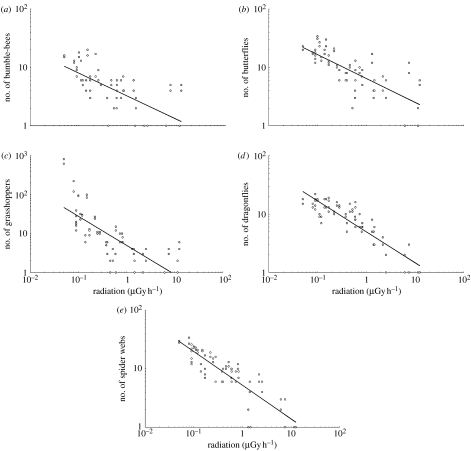Abstract
Effects of low-level radiation on abundance of animals are poorly known. We conducted standardized point counts and line transects of bumble-bees, butterflies, grasshoppers, dragonflies and spider webs at forest sites around Chernobyl differing in background radiation by over four orders of magnitude. Abundance of invertebrates decreased with increasing radiation, even after controlling for factors such as soil type, habitat and height of vegetation. These effects were stronger when comparing plots differing in radiation within rather than among sites, implying that the ecological effects of radiation from Chernobyl on animals are greater than previously assumed.
Keywords: dragonflies, ecosystem, grasshoppers, pollinators, spiders
1. Introduction
The ecological consequences of radiation from Chernobyl are poorly known (Møller & Mousseau 2006). Surprisingly, there are few data on the abundance of animals in relation to radiation, and there have been no efforts to extensively census invertebrates in relation to radiation. The few studies published are mainly based on sampling in a few locations, making it difficult to generalize about the effects of radiation when compared with other factors (Krivolutsky & Pokarshevsky 1992; Sokolov et al. 1994; Maksimova 2002; Jackson et al. 2005).
The objectives of this study were to assess the abundance of invertebrate taxa in relation to background radiation. These were insect pollinators (bumble-bees and butterflies), an important taxon of herbivores (grasshoppers) and predators (dragonflies: and spiders). We conducted two kinds of census: point counts covering more than 700 sites during 3 years and line transects. This is by far the most extensive dataset on the abundance of animals from Chernobyl. Abundance can be affected by environmental factors other than radiation, and, therefore, we controlled statistically for potentially confounding variables that could affect the relationship between abundance and level of radiation. Line transects provided a powerful within-site experimental design controlling for many confounding variables because neighbouring sites that differ in the level of radiation by definition are similar in most respects, including soil type, habitat and other features.
2. Material and methods
A.P.M. conducted 731 standard point counts over the 3 years, late May–early June 2006–2008, within forested areas around Chernobyl, each count lasting 5 min during which all birds seen or heard, bumble-bees, butterflies, spider webs and dragonflies (dragonflies were only censused in 2008) were recorded (Møller 1983; Bibby et al. 2005). Points were located at 75 m intervals. Grasshoppers were censused during early September 2007 at 374 points.
We conducted four line transects at 17 sites during early July 2008 within and just outside the southern border of the exclusion zone. At each site, we pre-selected plots with high and low radiation (high radiation: 0.60 μGy h−1 (s.e.=1.29), low radiation: 0.38 μGy h−1 (1.29)). At each plot, A.P.M. conducted two line transects along roads in opposite directions, each of 50 m. Walking speed was slow, each transect lasting 10 min. Half an hour later, the same line transects were conducted once more without reference to the first census results.
Invertebrate abundance estimates can be affected by habitat (agricultural habitats with grassland or shrub, deciduous forest or coniferous forest estimated to the nearest 10% of ground coverage within 50 m from each of the observation points), maximum height of trees estimated to the nearest 5 m, soil type (loam/clay or sand), presence or absence of open water within 50 m from each point, cloud cover at the start of each point count (to the nearest eighth), temperature (range 12–28°C) and wind force (Beaufort, range 0–4). For each point count, we recorded time of day (to the nearest minute). Because the activity of many invertebrates is curvilinearly related to time of day, with high levels of activity in the middle of the day (e.g. Barnes et al. 2001), we also included time squared in the analyses.
Once having finished a 5 min census, we measured α, β and γ radiations two to three times at ground level using a hand-held dosimeter (Model: Inspector, SE International, Inc., Summertown, TN, USA). Cross-validation against data from Shestopalov (1996) revealed a strong positive relationship (linear regression on log–log transformed data: F=1546.49, d.f.=1,252, r2=0.86, p<0.0001, slope (s.e.)=1.28 (0.10)), suggesting reliability of our estimates.
Abundance of invertebrates and radiation level were log transformed, while coverage with farmland and deciduous forest was square-root arcsine transformed. We developed best-fit models to assess the relationship between invertebrate abundance (dependent variable) and radiation, after the inclusion of potentially confounding environmental variables, as implemented in JMP (SAS Institute Inc. 2000). Model selection was based on Akaike's information criterion (AIC), using the criterion of delta AIC<2.00 for exclusion of variables (Burnham & Anderson 2002). We analysed line transect data by using abundance as the response variable and site, level of radiation and their interaction as predictor variables. Frequency distributions of invertebrate counts were skewed, with disproportionately many zeros. However, we obtained similar results with Kendall rank-order correlation and partial rank-order correlation (controlling for confounding variables in table S2 in the electronic supplementary material).
3. Results
The abundance of invertebrates decreased with increasing radiation (figure 1). We recorded 298 bumble-bees with Bombus terrestris accounting for 72.6 per cent of all observations (see table S1 in the electronic supplementary material). Abundance of bumble-bees decreased between normal background radiation levels and the most contaminated areas (figure 1a). In addition, there were effects of year, temperature, wind and habitat on the abundance of bumble-bees (see table S2 in the electronic supplementary material). We recorded 389 butterflies with Aporia crataegi accounting for 36.6 per cent (see table S3 in the electronic supplementary material). Again, abundance decreased significantly between sites with level of contamination (figure 1b). Abundance of butterflies was additionally explained by time of day, wind and habitat (see table S2 in the electronic supplementary material).
Figure 1.
Abundance of (a) bumble-bees, (b) butterflies, (c) grasshoppers, (d) dragonflies and (e) spider webs estimated during point counts in 2006–2008 in relation to background radiation (μGy h−1) for forested locations around Chernobyl, Ukraine and Belarus. (The lines are the linear regression lines.)
We recorded 305 grasshoppers during our point counts. Abundance decreased significantly with radiation (figure 1c), with additional effects of date, time of day, temperature, cloud cover and habitat (see table S2 in the electronic supplementary material). The total number of dragonflies was 105 during point counts, with abundance decreasing significantly with radiation (figure 1d), time of day and habitat (see table 1D in the electronic supplementary material). Finally, we recorded 775 spider webs, with abundance declining with radiation (figure 1e), year, temperature and wind (see table S2 in the electronic supplementary material).
The census results from repeated line transects were consistent (see table S4 in the electronic supplementary material). All five invertebrate taxa decreased significantly in abundance with increased radiation (figure 2), with intermediate to large effects (sensu Cohen 1988) accounting for 14–38 per cent of the variance (see table S4 in the electronic supplementary material). There were also significant site effects, with the exception of spider webs (see table S4 in the electronic supplementary material). Grasshoppers and butterflies showed significant interactions between radiation and site (see table S4 in the electronic supplementary material).
Figure 2.
Abundance of (a) bumble-bees, (b) butterflies, (c) grasshoppers, (d) dragonflies and (e) spider webs estimated during line transects in July 2008 in relation to background radiation (μGy h−1) around Chernobyl, Ukraine and Belarus. (The lines are the linear regression lines.)
4. Discussion
We found declining abundance of invertebrates with radiation near Chernobyl, especially in line transects that controlled for confounding environmental variables through within-site comparisons. The only comparable data for abundance and diversity of birds in Chernobyl show similar patterns (Møller & Mousseau 2007). The negative relationship extended to the range 0.01–1 μGy h−1 (figures 1 and 2), suggesting that invertebrates are affected even at levels of contamination below one hundred times normal levels.
Most radiation around Chernobyl is currently in the topmost soil (Shestopalov 1996), where most invertebrates live. For example, butterfly eggs, larvae or pupae spend time in the soil layer or the vegetation just above. This could negatively affect survival and fecundity, and hence abundance. Alternatively, indirect effects of radiation on prey could potentially explain the reduced abundance of spiders and dragonflies, but not the reduced abundance of bumble-bees, butterflies and grasshoppers.
Point counts covered many different sites, implying that factors other than radiation varied among sites. Not surprisingly, we, on average, explained only 6 per cent of the variance. The second kind of census based on a within-site design better controlled for confounding variables. On average, the relationship between abundance and radiation explained 22 per cent of the variance based on transects.
These results have implications for ecosystems and overall ecosystem functioning. Reduced abundance of pollinators generally affects plant fecundity and seed set, when plant fecundity is pollen limited (Proctor 1996). Likewise, spiders are important predators (Wise 1993), and reductions in abundance can have important consequences for abundance of other invertebrate taxa (e.g. Snyder & Wise 2001). Pollination and predation are considered important ecosystem services (Costanza et al. 1997), and disruption may affect the overall ecosystem functioning, suggesting that the Chernobyl region and its surroundings is a perturbed ecosystem.
Acknowledgements
We acknowledge help from I. Chizhevsky, G. Milinevski, G. Rudolfsen, S. Rushkovsky and N. Saino. We gratefully acknowledge support from US National Science Foundation, Samuel Freeman Charitable Trust, CRDF, NATO CLG program, Fulbright Program and National Geographic Society.
Supplementary Material
References
- Barnes R.S.K., Calow P., Olive P.J.W., Golding D.W., Spicer J.J. Blackwell; Malden, MA: 2001. The invertebrates. [Google Scholar]
- Bibby C.J., Hill D.A., Burgess N.D., Mustoe S. Academic Press; London, UK: 2005. Bird census techniques. [Google Scholar]
- Burnham K.P., Anderson D.R. 2nd edn. Springer; New York, NY: 2002. Model selection and multimodel inference. [Google Scholar]
- Cohen J. 2nd edn. Lawrence Erlbaum; Hillsdale, NJ: 1988. Statistical power analysis for the behavioral sciences. [Google Scholar]
- Costanza R., et al. The value of the world's ecosystem services and natural capital. Nature. 1997;387:253–260. doi:10.1038/387253a0 [Google Scholar]
- Jackson D., Copplestone D., Stone D.M., Smith G.M. Terrestrial invertebrate population studies in the Chernobyl exclusion zone, Ukraine. Radioprotection. 2005;40:S857–S863. doi:10.1051/radiopro:2005s1-126 [Google Scholar]
- Krivolutsky D.A., Pokarshevsky I. Effects of radioactive fallout on soil animals populations in the 30 km zone of the Chernobyl atomic power plant. Sci. Total Environ. 1992;112:69–77. doi: 10.1016/0048-9697(92)90239-o. doi:10.1016/0048-9697(92)90239-O [DOI] [PubMed] [Google Scholar]
- Maksimova S. The effect of radioactive contamination caused by the Chernobyl nuclear accident on Diplopoda communities. Acta Zool. Lituanica. 2002;12:90–94. [Google Scholar]
- Møller A.P. Nordic Council of Ministers; Oslo, Norway: 1983. Methods for monitoring bird populations in the Nordic countries. [Google Scholar]
- Møller A.P., Mousseau T.A. Biological consequences of Chernobyl: 20 years after the disaster. Trends Ecol. Evol. 2006;21:200–207. doi: 10.1016/j.tree.2006.01.008. doi:10.1016/j.tree.2006.01.008 [DOI] [PubMed] [Google Scholar]
- Møller A.P., Mousseau T.A. Species richness and abundance of birds in relation to radiation at Chernobyl. Biol. Lett. 2007;3:483–486. doi: 10.1098/rsbl.2007.0226. doi:10.1098/rsbl.2007.0226 [DOI] [PMC free article] [PubMed] [Google Scholar]
- Proctor M. Timber Press; Portland, OR: 1996. The natural history of pollination. [Google Scholar]
- SAS Institute Inc. SAS Institute Inc; Cary, NC: 2000. JMP. [Google Scholar]
- Shestopalov V.M. Ukrainian Academy of Science; Kiev, Ukraine: 1996. Atlas of Chernobyl exclusion zone. [Google Scholar]
- Snyder W.E., Wise D.H. Contrasting trophic cascades generated by a community of generalist predators. Ecology. 2001;82:1571–1583. doi:10.2307/2679801 [Google Scholar]
- Sokolov V.E., Ryabov I.N., Ryabtsev I.A., Kulikov A.O., Tichomirov F.A., Sheheglov A.I. Effects of radioactive contamination on the flora and fauna in the vicinity of Chernobyl nuclear power plant. Sov. Sci. Rev. F Physiol. Gen. Biol. Rev. 1994;8:1–124. [Google Scholar]
- Wise D.H. Cambridge University Press; Cambridge, UK: 1993. Spiders in ecological webs. [Google Scholar]
Associated Data
This section collects any data citations, data availability statements, or supplementary materials included in this article.




